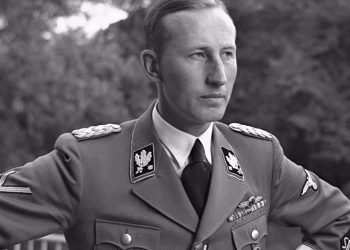Human Lives Human Rights: Beginning on the night of June 9–10, 1942, German police and SS officials destroyed the Czech town of Lidice in the Protectorate of Bohemia and Moravia (the German-occupied Czech lands). The Nazis destroyed Lidice as a reprisal action for the assassination and death of Reinhard Heydrich, a high-ranking Nazi leader. The Germans falsely claimed that two families from the town of Lidice were somehow connected to the assassins and the Czech resistance.
In Lidice, the Germans shot the men of the town, and then deported most of the women and children. Next, they burned the town to the ground. They promised to obliterate the name of Lidice from the map of Europe.
The destruction of Lidice and the brutal treatment of its inhabitants was widely reported internationally. Lidice became a symbol of Nazi Germany’s wartime brutality.
“Operation Anthropoid”: The Assassination of Reinhard Heydrich
The Nazi annihilation of Lidice was a reprisal action. It was perpetrated in response to the assassination and death of Nazi leader Reinhard Heydrich. Heydrich’s assassination was a top-secret, joint British and Czechoslovak operation. It was code-named “Operation Anthropoid.”
Planning the Assasination
“Operation Anthropoid” was planned in London by the British Special Operations Executive (SOE) and the Czechoslovak government-in-exile led by Edvard Beneš. By assassinating a high-level Nazi official, the SOE hoped to demonstrate its effectiveness. Meanwhile, the Czechoslovak leaders in London hoped to prove to the Allies that the Czechs were willing to resist the Nazis.
The leaders of the operation chose to assassinate Reinhard Heydrich, who held several important positions in the Nazi regime. As head of the Reich Security Main Office (RSHA), he was responsible for the SS intelligence service (SD) and the Security Police. He was also a leading architect of the “Final Solution,” the mass murder of European Jews. The SOE described him in a secret memo as “probably the second most dangerous man in German-occupied Europe.”
Beginning in fall 1941, Heydrich served as Acting Reich Protector of the Protectorate of Bohemia and Moravia. In this position, he oversaw harsh occupation policies, including the Nazi persecution of Czech Jews. He also implemented policies that aimed to eradicate Czech culture and Germanize the Czech population.
Thus, from both the Czech and British perspectives, Heydrich seemed like an appropriate target to rouse resistance in the Protectorate of Bohemia and Moravia.
The SOE trained a group of Czechoslovak resistance members in the tactics and skills necessary to carry out the assassination. The British helped nine resistance members parachute into the Czech countryside on the night of December 28, 1941. Among them were Jan Kubiš and Jozef Gabčík, the two men tasked with killing Heydrich. It took Kubiš and Gabčík five months to plan and set up the assassination attempt. In the meantime, the two men hid with various members of the local Czech resistance, who did not support the assasination plan. According to the local leadership, Kubiš and Gabčík’s presence endangered the entire Czech resistance network.
On May 27, 1942, Gabčík attempted to shoot Heydrich as Heydrich’s car slowed around a tight curve in a Prague street. However, Gabčík’s submachine gun jammed. This forced Kubiš to throw a bomb at the automobile. The bomb exploded near the rear wheel and injured Heydrich, who had ordered the chauffeur to stop the car, so he could shoot back at Gabčík.
Heydrich was not mortally wounded by the blast. However, shrapnel from the explosion required Heydrich to be hospitalized, and led to septicemia (blood poisoning by bacteria). Heydrich died from this infection on June 4, 1942.
German Plans for Retaliation
The May 27 assasination attempt on Heydrich infuriated Nazi leadership. An outraged Adolf Hitler demanded the murder of up to 10,000 Czechs as revenge for the attack. Higher SS and Police Leader of the Protectorate of Bohemia and Moravia (HSSPF) Karl Hermann Frank flew from Prague to Berlin to dissuade Hitler from taking such drastic measures. Frank argued that this type of reprisal might interfere with long-term economic and political plans for the region. However, Frank did not intend to go easy on the Czechs. On May 27, he imposed martial law in the Protectorate and initiated a manhunt for the assassins.
On June 9, the day of Heydrich’s state funeral in Berlin, Hitler ordered the annihilation of Lidice. This choice was somewhat arbitrary. The town had been named in a letter found during the first days of the SS and police investigations into the attack on Heydrich. Desperate for leads, the Germans singled out Lidice as the site of retaliation. However, there was no real evidence connecting the people of the town with the assassins. But the Nazis used even the smallest pretext to take revenge for Heydrich’s death.
The Fate of Lidice
On the night of June 9–10, German police and SS officials surrounded Lidice. They ordered the approximately 500 residents to gather in the village square. Once the townspeople assembled, members of the SS and police separated men and boys fifteen years and older from the women and younger children. Almost immediately, the Germans shot 173 men and boys at a local farmstead. They then razed the town to the ground. In the following weeks, the Germans executed more than 20 other townspeople from Lidice at a shooting range in Prague.
A different fate awaited the women and children of Lidice, who were sent to a nearby town. There, they were again separated. Most women and girls 16 years and older were deported to Ravensbrück concentration camp. Of the 203 women from Lidice, 53 died in the Nazi concentration camp system before the end of World War II. Seven women were shot alongside the men of their families.
Most of Lidice’s children were sent to Lodz, a city in German-occupied Poland. There, SS personnel from the SS Race and Settlement Main Office screened the children for what they considered to be racial characteristics. They determined that nine of the children had a supposedly Germanic racial background. Selected for Germanization, these children were sent to a group home in German-occupied Poland. There, they were given new German names and taught to speak German. Officials from the Lebensborn program then placed them with adoptive German parents.
The Germans murdered the approximately 80 other Lidice children whom they had not selected for Germanization. Evidence suggests that this group of children was gassed at the Chelmno killing center.
A few Lidice children were not sent to Lodz. Seven children under the age of one were sent to a German orphanage in Prague. Another seven Lidice children were born in the months that followed the town’s annihilation. Most of these newborns were also placed in orphanages. Of these fourteen very young children, eight survived the war.
The Nazis annihilated the town of Lidice and destroyed the families who lived there. Not a single Lidice family survived the war without experiencing devastating loss.
The Fate of the Assassins
As the Nazis searched for Heydrich’s assassins, they uncovered and arrested many members of the Czech resistance. On June 18, SS and police discovered the assassins Kubiš and Gabčík, along with several other resistance fighters, in the Orthodox Cathedral of Saints Cyril and Methodius in Prague. A skirmish ensued. Kubiš died of wounds incurred in the firefight with SS and police officials. Gabčík and the other resistance fighters committed suicide in order to evade capture. The families of the assassins and other Czech resisters were sent to the Mauthausen concentration camp where they were subsequently killed.
The Town of Ležáky and Other Reprisals
The Nazis did not stop their retaliation efforts with Lidice. They carried out further reprisals in the Protectorate of Bohemia and Moravia.
The fifty-person village of Ležáky was treated similarly to Lidice. On June 24, 1942, Ležáky’s adult residents, both men and women, were shot. Thirteen children were sent to Lodz. Two sisters were selected for Germanization. The rest of the children were killed, probably in the Chełmno killing center. The small town was razed to its foundations.
Other reprisals in the Protectorate resulted in 3,188 Czechs arrested and 1,327 sentenced to death. As part of the reprisals for Heydrich’s assassination, thousands of Jews from Prague were deported to the Lublin concentration camp (also called “Majdanek”), as well as to other camps.
Nazi Propaganda about the Annihilation of Lidice
Nazi propagandists filmed the physical destruction of Lidice. Footage shows burning homes, the demolition of buildings, and German officials standing among the ruins. The film was supposed to document the repercussions of resisting German rule. German radio proudly reported on the annihilation of Lidice.
Stories about the annihilation of Lidice appeared in international newspapers in mid-June. The killings, deportations, and destruction became an international symbol of Nazi brutality.
In 1944, exiled German author Thomas Mann wrote:
The Nazis are stupid beasts. They wanted to consign the name of Lidice to eternal oblivion, and they have engraved it forever into the memory of man by their atrocious deed. Hardly anyone knew this name before they … razed it to the ground; now it is world famous.
Seeking Justice and Memorializing Lidice
The Lidice survivors, 143 women and 17 children, faced a devastating reality at the end of World War II. Their family members had been killed and their homes were destroyed. Mothers had lost their husbands and children, while children had lost their fathers and siblings.
But Lidice was not forgotten. It remained a powerful symbol of Nazi brutality. In fact, the Nazi film footage of the destruction of Lidice was shown at the International Military Tribunal at Nuremberg to illustrate Nazi brutality. The Allied prosecutors specifically spoke about the annihilation of the town as an example of Nazi war crimes.
Executing Karl Hermann Frank
Karl Hermann Frank, the Higher SS and Police Leader who had ordered the destruction of Lidice, was arrested and tried by the Prague People’s Court in 1946. Frank’s crimes seemed especially horrific because he was a Sudeten German. This meant that prior to Nazi Germany’s dismantling of Czechoslovakia in 1938–1939, he had been a Czechoslovak citizen. He was convicted for his many wartime crimes, including the annihilation of Lidice and Ležáky.
Among the spectators who watched his execution were seven women from Lidice.
Despite their horrifying experiences, two young Lidice survivors, Marie Doležalová and Marie Hanfová, testified at a subsequent Nuremberg trial (case #8 against leading officials from the SS Race and Resettlement, Doležalová and Hanfová were nine and eleven years old at the time of the massacre and were among the children forced to undergo Germanization. In their testimonies, they described what had happened to them, their families, and their neighbors during the annihilation of Lidice.
Memorializing Lidice
On June 10, 1945, the Czechoslovak government announced that they would rebuild Lidice. Construction of the new town began in 1948 near the ruins of the original. Later, the government turned the ruins into a museum and memorial site. The new Lidice was populated by some of those who had survived the town’s annihilation.
Many of the Lidice survivors worked at the memorial and attempted to keep the memory of the original town and their loved ones alive.














